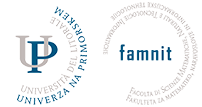Predstavitev projekta
Naslov: Linearne kode preko posebnih razredov funkcij - relacije in načrtovanje
Šifra projekta: J1-60012
Vodilna institucija: UP IAM
Partnerska institucija: UP FAMNIT
Vodja projekta na UP FAMNIT: dr. Enes Pasalic
Financer projekta: Javna agencija za znanstvenoraziskovalno in inovacijsko dejavnost Republike Slovenije (ARIS)
Raziskovalno področje (ARIS): 1.01 - Matematika
Vrsta projekta: Temeljni raziskovalni projekt - manjši
Trajanje projekta: 1. 1. 2025–31. 12. 2027
Opis projekta:
Glavni cilj tega projekta je izboljšati naše razumevanje določenih kombinatoričnih objektov. Glavni med njimi so določeni specifični razredi (vektorskih) Boolovih funkcij in linearnih kod, ki nosijo dodatne lastnosti, ki so se izkazale za uporabne v določenih kriptografskih aplikacijah. Če naštejemo nekaj teh aplikacij, so sheme za deljenje skrivnosti (z uporabo minimalnih linearnih kod) ali kod za popravljanje napak v kontekstu postkvantne kriptografije (preko samo-pravokotnih kod). Linearna koda (n,k,d) z abecedo iz končnega polja GF(q) je podprostor dimenzije k polja GF(q)n, katerega minimalna razdalja d mora biti maksimirana. Dobre linearne kode nad poljem GF(2) (ki so včasih optimalne) je mogoče izpeljati z uporabo nekaterih posebnih razredi vektorskih Boolovih funkcij, kot so APN (skoraj popolnoma nelinearne) in AB (skoraj ukrivljene) funkcije, ki so preprosto preslikave iz polja GF(2) n v polje GF(2) n.
Končni cilj predlaganega projekta je iskanje nadaljnjih povezav med določenimi pomembnimi diskretnimi strukturami, ki lahko povečajo naše znanje o njihovem strukturnem obnašanju.
Oddelek UP FAMNIT, v okviru katerega se izvaja projekt:
Oddelek za informacijske znanosti in tehnologije

Project presentationna vrh
Title: Linear codes through special classes of functions–relationship and design
Project acronym: J1-60012
Leading institution: UP IAM
Partner institutions: UP FAMNIT
Principal investigator at UP FAMNIT: dr. Enes Pasalic
Funding organization: Slovenian Research and Innovation Agency (ARIS)
Research field (ARIS): 1.01 - Mathematics
Duration: 1. 1. 2025–31. 12. 2027
Description:
The main goal of this project is to refine our understanding of certain combinatorial objects (mainly some specific classes of (vectorial) Boolean functions) and the design of linear codes that are characterized with some additional properties that are proved useful in certain cryptographic applications. To name a few, these applications may concern implementation of secret sharing schemes (using minimal linear codes) or error-correcting codes in the context of postquantum cryptography (via self-orthogonal codes). An (n,k,d) linear code with alphabet in a finite field GF(q) is simply a subspace of dimension k of GF(q)n, whose minimum distance d needs to be maximized. Good linear codes over GF(2) (that are sometimes optimal) can be derived using some special classes of vectorial Boolean functions such as APN (almost perfect nonlinear) and AB (almost bent) functions, which are simply mappings from to . As already noted by Cunsheng Ding in 2020, all projective binary linear codes stem from a certain Boolean function when the so-called defining set method is applied to a suitable subset D of . However, the choice of D is not straightforward and there are no exact rules or criteria that can be applied for its optimal selection. From the known design approaches, it is apparent that a certain combinatorial structure is necessarily imposed for the defining sets (e.g. support of a bent function) both for the purpose of easier analysis and better control of the code parameters. Therefore, the underlying combinatorial structure of certain classes of (vectorial) Boolean functions (such as APN, AB, bent and plateaued functions) seems to play a crucial role in this context. Our main intention is to deepen our understanding of the connection between projective linear codes that are optimal and the particular classes of Boolean functions that give rise to such codes, thus trying to answer the important open problems raised by Cunsheng Ding (“The construction and weight distributions of all projective binary linear codes’’). Nevertheless, not all optimal linear codes are projective which implies that the defining set is then a multiset and the problem of specifying such codes is intrinsically hard. In this context, there are some initial observations (ongoing work) on the multiset D that generate optimal codes (as a modification of the bent support) but there is no proper understanding of this process.
Concludingly, the proposed project aims at finding further connections between certain important discrete structures which may increase our knowledge about their structural behaviour.









